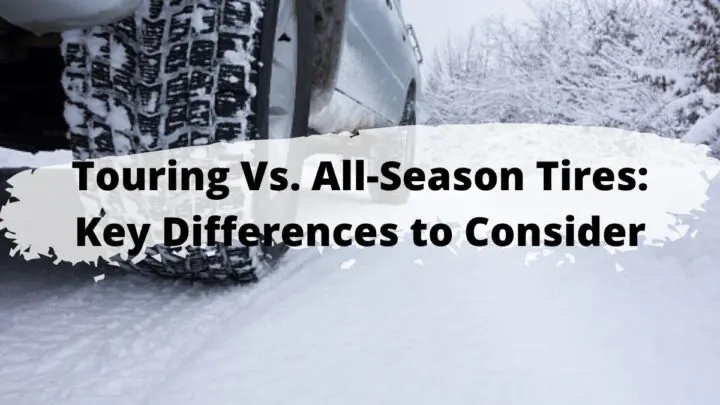Touring tires are very different from all-season tires across the globe. However, in North America, the line between the two is very slim.
Touring tires offer a blend of performance and versatility found in all-season tires. They provide a balanced handling, good traction, and grip found in performance tires and durability found in all-season tires.
But are they the same thing? No. Touring tires also have a higher speed rating than all-season tires!
Additionally, are touring tires improved versions of all-season tires? Why do we refer to them as touring all-season tires?
Read on to find out.
This article covers everything you need to know about touring and all-season tires to understand the two better. Let’s get going.
Is a Touring Tire the Same as an All-Season Tire?
No. Touring tires offer greater lifetime mileages, whereas all-season tires offer better versatility.
In other words, touring tires, by design, provide better comfort and handling over more extended periods.
By comparison, all-season tires offer better handling, traction, and comfort across different weather/ road conditions.
They aren’t mainly the best in any weather condition but will provide decent traction across any road condition.
What Are All-Season Tires?
All-season tires, just like the name states, provide good traction in all weather conditions.
As a result, they’re the most common tires on our roads.
If you walk out right now, there’s a great chance that most of the cars in your parking lot have all-season tires.
They have a unique symmetrical tread pattern that offers sufficient grip and traction across all road conditions.
The rubber will remain flexible and soft for a more outstanding grip in dry road conditions.
On wet roads, the treads, by design, dispatch water from underneath the tires, ensuring that the car doesn’t glide over a film of water.
However, all-season tires don’t excel in any particular weather condition. They’re more of a balanced tire than a substitute for weather-specific tires.
They fall short when compared to performance, touring, and winter tires.
Furthermore, all-season tires have less grip on icy roads or roads with temperatures of less than 7°C. The tire will get stiffer, offer less traction, and skid while braking.
Furthermore, all-season tires offer sufficient traction on snow and icy roads, depending on their grade. But you should remember that they aren’t a substitute for winter tires.
If you’re an aggressive driver, go for winter tires, as all-season tires suit smoother drivers.
What Are Touring Tires?
Touring tires are also known as touring all-season/ grand touring tires.
A standard definition of touring tires is that they are “tires for drivers who prefer long tire wear, a smooth, comfortable ride, and balanced handling.”
They have a wide, low profile, an asymmetrical tread pattern that gives them a better grip and traction sufficient for dry and wet road conditions.
Also, they’re more comfortable owing to their wider contact patch that offers maximum grip while accelerating, braking, steering, or cornering.
Touring tires came up due to a need for better all-rounded tires that can combine longevity and service. Traditionally, most tires excelled in certain weather conditions while underperforming in others.
And as we know, present-day cars are more efficient than their older counterparts and need better tires to maximize their performance. In response, tire manufacturers came up with touring tires.
They have longer thread life, making them suitable for long-distance travel. If you’re planning to travel across the nation where weather conditions vary, touring tires are your best choice.

Key Differences Between All-Season and Touring Tires
As we’ve seen, touring and all-season tires are closely related but serve very different purposes. And to do so, there must be distinct features that differentiate the two.
Here’s a list of the key differences between the two tires.
1. Tread Pattern
All-season tires feature symmetrical tread patterns plus circumferential grooves to provide good traction on wet surfaces.
On the other hand, the touring tires, in addition to providing all-season traction, offer more responsive handling. They have an asymmetrical/ rib tread pattern that provides a smooth driving experience.
2. Speed Rating
All-season tires offer all-around traction across any season or road condition. Therefore, they have a lower speed rating than touring tires.
On the other hand, touring tires have large lateral and circumferential grooves that closely resemble performance tires.
They have a higher speed rating than all-season tires.
3. Sidewall Profile
Touring tires have a lower sidewall profile than all-season tires.
The shorter sidewalls aren’t so flexible, ensuring that your vehicle doesn’t bounce a lot. Furthermore, having low sidewall profiles smoothen your drive as it improves grip and suspension, enhancing your vehicle’s stability.
On the other hand, all-season tires aren’t meant for performance and have a bigger profile than touring tires. In the end, bigger profiles improve your car’s miles per gallon (MPG) rating.
4. Price
All-season tires are generally cheaper than touring tires; touring tires usually cost 10 – 20 percent more than all-season tires.
They offer a greater versatility at the expense of some steering, braking, and acceleration. However, some all-season tires are way more expensive than some touring tires.
5. Tread Life
Touring tires are an enhanced version of the all-season tires, offering up to 90,000 miles. On the other hand, good-quality all-season tires last 60,000 to 85,000 miles. So, both tires have similar tread lives.
I’d recommend that you rotate your tires to prolong their tread lives.
Is It Worth Buying Touring Tires?
Yes. Touring tires are a good fit for everyday travels since the tires have a relatively longer tread life than the all-season tires.
Additionally, they’re a blend of performance and all-season tires. They offer a balanced handling, good traction, and grip found in performance tires and durability found in all-season tires.
The touring tire is for you if you want a tire that offers a bit more performance, better acceleration, higher speed rating, and good traction at the correct prices.
Don’t fear to spend on the tires, as you’ll enjoy a quieter and more comfortable ride across all weather conditions.
Conclusion
The difference between high-quality all-season and touring tires is minimal, and picking one depends on an individual’s preference.
All-season tires drive well, have good traction, and offer an excellent steering and cornering performance.
On the other hand, the touring tires provide better comfort, reduced noise, and outstanding performance. And as we’ve seen, touring tires are improved all-season tires, a blend of all-season and performance tires.
Be ready to spend more to get a high-quality touring tire. However, tire manufacturers don’t make equal-grade tires.
What some may term as high-quality touring tires may underperform compared to some all-season tires.
Regardless, avoid any cheap tires!
